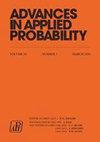Asymptotic results on tail moment and tail central moment for dependent risks
IF 1.2
4区 数学
Q3 STATISTICS & PROBABILITY
引用次数: 1
Abstract
In this paper, we consider a financial or insurance system with a finite number of individual risks described by real-valued random variables. We focus on two kinds of risk measures, referred to as the tail moment (TM) and the tail central moment (TCM), which are defined as the conditional moment and conditional central moment of some individual risk in the event of system crisis. The first-order TM and the second-order TCM coincide with the popular risk measures called the marginal expected shortfall and the tail variance, respectively. We derive asymptotic expressions for the TM and TCM with any positive integer orders, when the individual risks are pairwise asymptotically independent and have distributions from certain classes that contain both light-tailed and heavy-tailed distributions. The formulas obtained possess concise forms unrelated to dependence structures, and hence enable us to estimate the TM and TCM efficiently. To demonstrate the wide application of our results, we revisit some issues related to premium principles and optimal capital allocation from the asymptotic point of view. We also give a numerical study on the relative errors of the asymptotic results obtained, under some specific scenarios when there are two individual risks in the system. The corresponding asymptotic properties of the degenerate univariate versions of the TM and TCM are discussed separately in an appendix at the end of the paper.相依风险的尾矩和尾中心矩的渐近结果
在本文中,我们考虑了一个由实值随机变量描述的具有有限个个体风险的金融或保险系统。我们重点研究了两种风险度量,即尾部矩(TM)和尾部中心矩(TCM),它们被定义为在系统危机发生时某些个体风险的条件矩和条件中心矩。一阶TM和二阶TCM分别与被称为边际预期缺口和尾部方差的流行风险度量相一致。当个体风险是成对渐近独立的,并且具有包含轻尾分布和重尾分布的特定类别的分布时,我们导出了具有任何正整数阶的TM和TCM的渐近表达式。所获得的公式具有与依赖结构无关的简洁形式,因此使我们能够有效地估计TM和TCM。为了证明我们的结果的广泛应用,我们从渐近的角度重新审视了与溢价原则和最优资本配置有关的一些问题。我们还对在系统中存在两个单独风险的特定情况下所获得的渐近结果的相对误差进行了数值研究。在本文末尾的附录中,分别讨论了TM和TCM的退化单变量版本的相应渐近性质。
本文章由计算机程序翻译,如有差异,请以英文原文为准。
求助全文
约1分钟内获得全文
求助全文
来源期刊

Advances in Applied Probability
数学-统计学与概率论
CiteScore
2.00
自引率
0.00%
发文量
64
审稿时长
6-12 weeks
期刊介绍:
The Advances in Applied Probability has been published by the Applied Probability Trust for over four decades, and is a companion publication to the Journal of Applied Probability. It contains mathematical and scientific papers of interest to applied probabilists, with emphasis on applications in a broad spectrum of disciplines, including the biosciences, operations research, telecommunications, computer science, engineering, epidemiology, financial mathematics, the physical and social sciences, and any field where stochastic modeling is used.
A submission to Applied Probability represents a submission that may, at the Editor-in-Chief’s discretion, appear in either the Journal of Applied Probability or the Advances in Applied Probability. Typically, shorter papers appear in the Journal, with longer contributions appearing in the Advances.
 求助内容:
求助内容: 应助结果提醒方式:
应助结果提醒方式:


